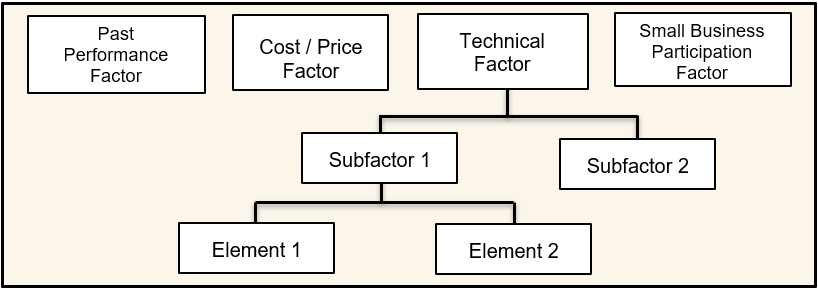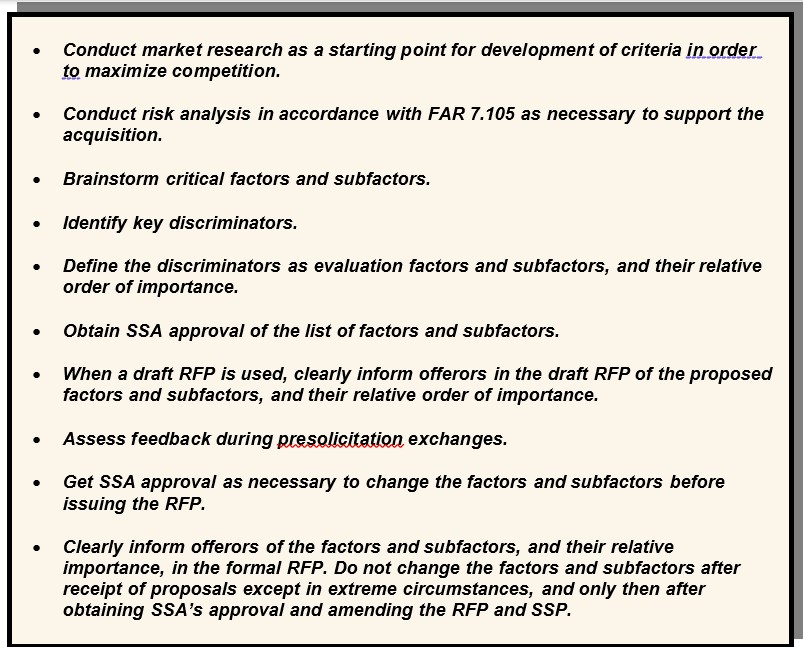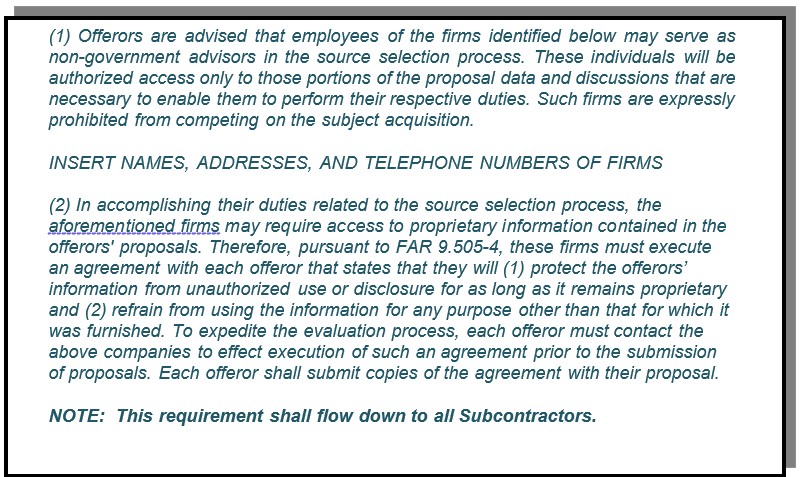2.2 Develop a Source Selection Plan
Selection of Evaluation Factors. Selecting the correct evaluation factors is the most important decision in the evaluation process. Structure the evaluation factors and their relative importance to clearly reflect the needs of your acquisition, with consideration given to the inclusion and evaluation of intellectual property/data rights and what is necessary and prudent be included in the acquisition.
Mandatory Evaluation Considerations. For source selections, you must evaluate cost/price (unless the exception at FAR 15.304(c)(1)(ii)(A) applies) and the acceptability/quality of the proposed product or service through one or more non-cost evaluation factors (e.g., past performance, technical excellence, management capability, and key personnel qualifications).
As stated at FAR 15.304(c)(1)(ii)(A)), the PCO may exclude cost/price as an evaluation factor for a Multiple Award IDIQ effort issued for the same or similar services if the Government intends to make award to all "qualifying offerors" and Cost/Price will be considered as one of the factors for all tasks/delivery orders.
Additionally, you must evaluate past performance on all negotiated competitive acquisitions expected to exceed the thresholds identified in FAR 15.304 and DFARS 215.304, unless the PCO documents why it would not be appropriate. There may be other required evaluation factors, such as small business participation, based upon regulatory and/or statutory requirements. (See FAR 1 5.304 and its supplements)
From this vantage point, the acquisition team must apply prudent business judgment to add other evaluation factors, subfactors, and elements that are important to selecting the most advantageous proposal(s). The number of factors and subfactors should be kept to the absolute minimum required to effectively assess the proposal(s). The use of more factors than needed to conduct the evaluation can complicate and extend the process, while providing no additional value and thereby diluting meaningful discriminators. Limiting factors also serves to reduce the evaluation oversight span-of-control responsibilities of the SSEB leadership, SSA/SSAC, PCO, and legal counsel, thereby permitting more focused oversight on the remaining (and most important) factors/subfactors and reducing the likelihood of evaluation errors.
Common evaluation factors are cost/price, technical, past performance, and small business participation.
NOTE: Ensure small business participation remains an independent factor, not subordinate and a subfactor to any other evaluation factor. Additionally, if appropriate for the requirement, you may have other evaluation factors and/or may use one or more levels of subfactors. The standard Army naming convention for the various levels is: Evaluation Factor, Subfactor, and Element. (See Figure 2-1)

Figure 2-1: Sample Evaluation Factor Structure
Establishing Evaluation Factors and Subfactors. The acquisition team develops the evaluation factors and any appropriate subfactors and elements. The team should select the factors based on user requirements, acquisition objectives, thorough market research and risk analysis. Figure 2-2 illustrates the steps involved in developing the factors and subfactors. The use of elements should only be utilized on rare occasions. (AFARS 5115.304)
Once the RFP is issued, the factors and subfactors give the offerors insight into the significant considerations the government will use in selecting the best value proposal and help them to understand the source selection process. Carefully consider whether minimum “acceptable/unacceptable” entry-gates can be included.
The team must also specify whether technical ratings will be applied at the subfactor level or rolled up to the factor level, with the information contained and clearly stated in the RFP so all stakeholders know how the evaluation of ratings will be applied.
NOTE: The Small Business Subcontracting Plan is not a factor or subfactor to be rated but, as stated at FAR 19.705-4, shall be reviewed for adequacy and determined to be “acceptable or unacceptable based the requirements identified at FAR 19.704. When used properly, this use of entry-gate criteria can streamline the evaluation process significantly.”

Figure 2-2: Steps Involved in Formulating Evaluation Factors and Subfactors
Nongovernment Advisors. Allowance and guidelines for use of contracted advisory services is stated at FAR 37.203, FAR 37.204, and FAR 37.205. If utilized, prior to issuing a solicitation, the head of the agency shall make a written determination based on availability of qualified personnel withing the agency. Nongovernment advisors may assist in and provide input regarding the evaluation, but they shall not determine ratings or rankings of the offeror’s proposals. Recommend clarifying allowances and or access that will be given the advisors (e.g., access to the entire proposal or only access to the part concerning their particular expertise? Can they write strengths and weaknesses or only assist other evaluators in this process? Can they participate in the consensus process without participating in/providing input for the rating assignment?).
Reminder, nongovernment sources can include academia, nonprofit institutions, and industry.
Reminder: When using nongovernment advisors, you must advise potential offerors of the nongovernment advisors’ participation in the source selection and obtain the offerors consent to provide access to its proprietary information to the nongovernment advisor or the company which employs the nongovernment advisor. Figure 2-3 identifies suggested RFP language relative to the use of commercial firms to support the source selection process. (Reference DoD Source Selection Procedures 2.2.8)

Figure 2-3: Suggested RFP Language for the use of Nongovernment Advisors
Source Selection for Services. The source selection process for services, including development of the SSP, is often very complex. Organizations must ensure that the SST is comprised of qualified personnel with specific knowledge of the types of services to be acquired.
The use of Sample Tasks is an effective tool in the evaluation of services. Sample Tasks can provide insight as to the offeror’s level of understanding of the work to be performed, as well as how the technical approach relates to the cost/price proposed for that Sample Task. (See Appendix H for an example of a Sample Task.)
To the maximum extent practicable, sample tasks should set forth requirements that are contemplated for award, establishing the expectation that offerors will be held accountable for the resources and costs they propose.
The use of generic or hypothetical sample tasks may unintentionally create an environment that misleads offerors to understate resources and costs due to the fact that the sample tasks will not be awarded. Care must be taken to draft the sample tasks as closely as possible to the types and scope of services expected to be acquired from the Performance Work Statement (PWS). If possible, consider the use of a “live” task, which would be awarded at time of contract award.
Evaluation criteria should be limited to essential areas of performance that are measurable during the proposal evaluation process. This will permit a more focused evaluation of the offeror’s proposed solution to the sample task.
If utilizing a sample task, ensure this is accounted for and aligned with Sections L and M (or equivalent sections for procurements not using uniform contract format (UCF)).